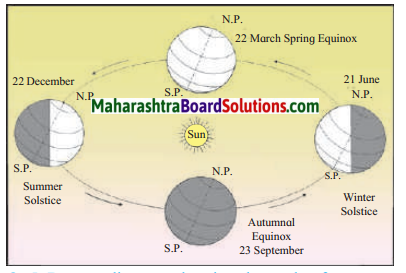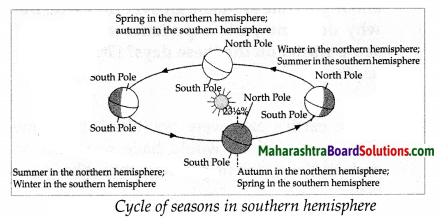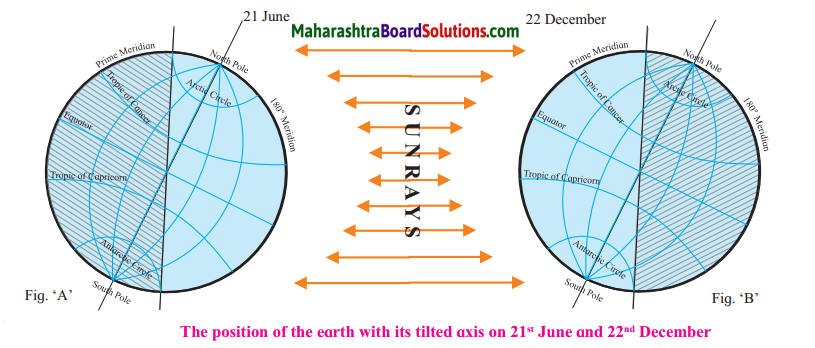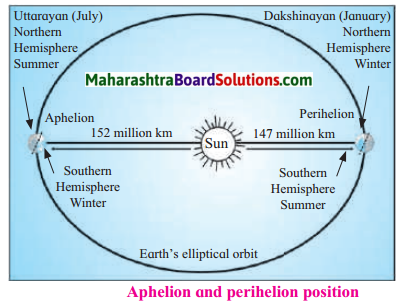Balbharti Maharashtra State Board Class 7 Geography Solutions Part 1 Chapter Chapter 8 How Seasons Occur Part 2 Notes, Textbook Exercise Important Questions and Answers.
Maharashtra State Board Class 7 Geography Solutions Chapter 8 How Seasons Occur Part 2
Class 7 Geography Chapter 8 How Seasons Occur Part 2 Textbook Questions and Answers
1. Complete the statements using correct options:
How Seasons Occur Part 2 Class 7 Question 1.
The apparent movement of the sun means that ________.
(a) the sun revolves around the earth in a year.
(b) it appears that the sun moves to the north or south in a year.
(c) the earth keeps on changing its position.
Answer:
(b) it appears that the sun moves to the north or south in a year.
![]()
How Seasons Occur Part 2 Question 2.
If the axis of the earth were not tilted ________.
(a) the earth would not have rotated around , itself.
(b) the earth would have revolved around the sun with greater velocity.
(c) different parallels on the earth would have experienced the same climate throughout the year.
Answer:
(c) different parallels on the earth would have experienced the same climate throughout the year.
How Seasons Occur – Part 2 Class 7 Questions And Answers Question 3.
21sl June and 22nd December are solstice days, that is ________.
(a) the sun starts its southward journey from Tropic of Cancer on 21st June and Northward journey from Tropic of Capricon on 22nd December.
(b) the Dakshinayan of the sun takes place between 21st June and 22nd December.
(c) the Uttarayan of the earth takes place between 22nd December and 21st June.
Answer:
(a) the sun starts its southward journey from Tropic of Cancer on 21st June and Northward journey from Tropic of Capricon on 22nd December.
How Seasons Occur – Part 2 Class 7 Answers Question 4.
The revolution of the earth around the Sun and the tilt of the axis of the earth together are responsible for the ______.
(a) summer, rainy season, retreat of monsoon, winter.
(b) summer, winter and spring.
(c) summer and winter.
Answer:
(c) summer and winter.
2. Answer the following questions:
How Seasons Occur – Part 2 Questions And Answers Question 1.
What leads to the occurrence of seasons?
Answer:
(i) Seasons occur due to the revolution of the earth.
(ii) Seasons also occur due to the tilt of the earth’s axis of rotation.
![]()
Class 7 Geography Chapter 8 How Seasons Occur Part 2 Question 2.
What is the duration of the day on equinox?
Answer:
(i) The circle of illumination divides all the parallels from the north pole to the south pole equally.
(ii) Everywhere on the earth, the night time and day time are of equal duration. This condition is called equinox.
(iii) Thus, the duration of the day will be twelve hours on equinox.
How Seasons Occur – Part 1 Class 7 Questions And Answers Question 3.
Why is the effect of the seasons not experienced in the equatorial region?
Answer:
(i) Seasons have been decided on the basis of the duration of sunlight, equinoxes & solstices
(i) The equatorial region receives perpendicular sunray almost throughout the year.
(ii) Hence the climate of that region does not change at all in the year.
(iii) Hence the effect of the seasons is not experienced in the equatorial region.
How Seasons Occur – Part 1 Questions And Answers Question 4.
Why is the sun visible for more than 24 hours during Dakshinayan in the region between the Antarctic Circle and the South Pole?
Answer:
(i) Sunrays are never perpendicular on any of the parallels between Tropic of Cancer & the North pole or between Tropic of Capricorn & the South pole.
(ii) In the period from 23rd September to 21st March (Dakshinayan) the region between Antarctic circle and the south faces the sun. The whole of Antarctic Circle falls within the zone of illumination.
(iii) So the sun is visible in the sky for more than 24 hours.
Geography Class 7 How Seasons Occur – Part 2 Question 5.
Why are penguins not found at the North Pole?
Answer:
(i) The living world on the earth is affected by the cycle of seasons.
(ii) Penguins are native to south pole. Penguins have adapted to the natural conditions prevailing in the Antarctic regions of the south pole.
(iii) Besides predators like polar bears roam within the Arctic Circle. Hence penguins are found at the South pole & not at the North pole.
3. Rewrite the following statements after correcting them:
Question 1.
The earth’s velocity varies according to the period of revolution.
Answer:
The earth’s velocity varies due to the rotation of the earth.
Question 2.
If we observe from the northern hemisphere we see the apparent movement of the sun.
Answer:
We see the apparent movement of the sun from both the northern & southern hemispheres.
Question 3.
The dates of equinox change every year.
Answer:
The dates of equinox does not change every year. They vary by a day or so.
Question 4.
North Canada experiences summer from September to March.
Answer:
North Canada experience winter from September to March.
![]()
Question 5.
When it is summer in South Africa, Australia has winter.
Answer:
When it is summer in South Africa, Australia has summer.
Question 6.
Duration of daytime is less on the vernal and autumnal equinoxes.
Answer:
On the vernal (spring) equinox and autumnal equinox, day and night time are of the same duration.
4. Spot the error in the diagram given below:

Answer:
Spring Equinox – 21st March
Summer Solstice – 21st June
Winter Solstice – 22nd December
5. Draw a diagram showing the cycle of seasons in the southern hemisphere.
Answer:

ICT Question :
Question 1.
Using the internet sites or a calendar, find and note the duration of the day for specific dates between 22nd March and 23rd September. Calculate the duration of the nights too. Using this information draw a compound bar graph.
Question 2.
Draw a diagram of aphelion and perihelion positions of the earth on the computer.
Activity:
Using the internet, collect pictorial information of any four migratory birds/animals.
Class 7 Geography Chapter 8 How Seasons Occur Part 2 InText Questions and Answers
Can you tell:
Figure shows the position of the earth with its tilted axis on 21st June and 22nd December. It also shows its illuminated and dark positions. Observe the figure and answer the following.

Question 1.
In fig ‘A which pole is receiving sunlight?
Answer:
North Pole is receiving sunlight in Fig ‘A’
Question 2.
In fig ‘B’ which pole is not receiving sunlight?
Answer:
North Pole is not receiving sunlight in Fig. ‘B’
Question 3.
Which hemisphere has the longest daytime on 21st June?
Answer:
Northern hemisphere has the longest daytime on 21st June.
Question 4.
Which hemisphere will have the longest night on 22nd December?
Answer:
Northern hemisphere will have the largest night in 22nd December.
![]()
Question 5.
On which date will the Tropic of Cancer receive perpendicular sunrays?
Answer:
The Tropic of Cancer will receive perpendicular sunrays on 21st June.
Question 6.
Considering the position of the north pole, which season will prevail in the northern hemisphere from 22nd March to 23rd September?
Answer:
Summer season will prevail in the northern hemisphere from 22nd March to 23rd September.
Question 7.
The cricket matches in Australia are generally in summer, when does Australia have summer?
Answer:
Summer season prevails in Australia from 23rd September to 21st March.
Question 8.
In which period is the ‘midnight sun’ observable in Norway? Which season will there be at that time?
Answer:
Midnight sun is observable in Norway from 21st March to 23rd September. It will be summer in Norway that time.
Question 9.
At what time will the midnight sun be visible at the “Bharati Research Station” of India at Antarctica? What will be the season there at that time?
Answer:
The midnight sun will be visible at Bharati Research Station of India at Antarctica from 23rd September to 21st March. It will be summer season there.
Use your brain power:
Question 1.
The summer capital of Jammu & Kashmir is Srinagar while the winter capital is Jammu. What could be the reason?
Answer:
(i) Jammu is located in the southern part of the state of Jammu & Kashmir whereas Srinagar is located to its north.
(ii) Also Jammu is located at an altitude of 350m whereas Srinagar is located at an altitude of approximately 1500m.
(iii) So Jammu has higher temperature in summer as compared to Srinagar. As Srinagar has pleasant climate in summer, it acts as summer capital of the state.
(iv) As winters are not very cold in Jammu & it is early accessible, it acts as a winter capital of the state.
Question 2.
While India & England are located in the same hemisphere why are the cricket matches in these two countries arranged in different months?
Answer:
(i) As India is a tropical country summers temperature are very high. England on the other hand falls in the temperate zone which has mild summers. Hence, England is suitable for cricket matches in summer.
(ii) As England lies in the temperate zone it her very cold winters. India on the other hand has mild winters as it is a tropical country. Thus India is suitable for cricket matches in winters. Hence, although India & England are located in the same hemisphere, due to latitudinal differences, the cricket matches in these two countries are arranged in different months.
Question 3.
On 21st March and 23rd September, daytime and night time are same all over the earth. But why do some parts experience summer and some winter on the these days?
Answer:
(i) If the earth’s axis were not tilted, the same climatic conditions would have prevailed on each of the different parallels throughout the year.
(ii) The seasons would not have occurred. It is due to the tilt of the earth’s axis that some parts of the earth experience summer and some winter on these days.
Question 4.
Mention any two countries in the world where one needs woollen clothing in the month of May. Also mention their latitudinal positions.
Answer:
South Africa is on 23°S latitude.
Iceland is on 65°N latitude.
Question 5.
On equinox days, the two poles experience either sunrise or sunset. On which pole will it be sunrise on 21st March?
Answer:
Sunrise will be experienced on the North pole.
Think about it:
Question 1.
In which direction will the location of sunrise and sunset appear to move after 22nd of December?
Answer:
On 22nd December the sun reaches the southernmost position as seen from the earth. The sun seems to stand still at the Tropic of Capricon and then reverses its direction. The sun appears to move northwards after 22nd December.
![]()
Observe Fig of textbook page 47 carefully & answer:

Question 2.
positioned relative to the sun on the dates given in the figure?
Answer:
(i) The northern hemisphere is tilted towards the sun in the period between 21st March is 23rd September. Hence, northern hemisphere experiences summer season.
(ii) It is tilted away from the sun in the period between 23rd September to 21st March. Hence, northern hemisphere experiences winter season.
Question 3.
Which season will you experience in the northern hemisphere around 22nd December?
Answer:
We will experience Winter season in the northern hemisphere around 22nd December.
Question 4.
What would be the season in the northern hemisphere around 21st June?
Answer:
It will be Summer season in the northern hemisphere around 21st June.
Question 5.
If it is winter in the northern hemisphere which season will it be in opposite hemisphere?
Answer:
If it is winter in the northern hemisphere, the southern hemisphere will experience summer season.
![]()
Question 6.
At any given point of time why are the season in the northern and southern hemisphere different?
Answer:
(i) Regardless of the time of the year, the northern and southern hemisphere experience opposite seasons.
(ii) In the period from 21st March to 23rd September the northern hemisphere is exposed to more direct sunlight because this hemisphere faces the sun.
(iii) In the period from 23rd September to 21st March the southern hemisphere is exposed to more direct sunlight.
(iv) It is the tilt of the Earth that causes the difference in the seasons.
Question 7.
What effects do the seasons have on the biodiversity in India? Write briefly about it:
Answer:
(i) The living world on the earth is affected by the cycle of seasons.
(ii) Change in seasons cause immense biodiversity loss, affecting both individual species and their ecosystem that support economic growth and human well being.
(iii) Greater frequency and severity of heat waves and extreme weather is a threat to the survival of mankind and animals too.
(iv) Floral and animal activity variation depends on seasonal temperature variation with different species flowering at specific times before or after monsoon seasons.
(v) Any change in rainfall pattern poses a threat to agriculture.
Give it a try:
Question 1.
Regarding daytime & the cycle of season, what conditions would have prevailed at the following place, if the earth’s axis were not tilled? (Canada, Tasmania, Nigeria, West Indies, Peru, Borneo)
Answer:
- Effect on day & night time: If the earth’s axis were not titled the duration of day time & night time would have been equal throughout the year.
- Effect on seasons: There would be no seasonal change on the earth.
- Canada and Tasmania would experience winter throughout the year as they are located near the poles.
- West Indies, Peru, Nigeria, Borneo would experience summer throughout the year as they are located near the equator.
Can you tell:
Discuss the activity you have been carrying out since June (Refer ch. 1) make use of the observation tables for the months of June, September & December.
Question 1.
In which month the duration of the day was around 12 hours?
Answer:
The duration of the day was around 12 hours in the month of September.
Question 2.
What could be the reason behind it?
Answer:
The duration of day is 12 hours in the month of September because both the hemispheres of the earth are at equal distance from the sun & the equator receives perpendicular rays of the sun.
Question 3.
Bring out the differences between the duration of daytime in the months of June, September & December.
Answer:
The duration of day is around 13 hours in the month of June. It decreases to around 12 hours in the month of September. It is around 11 hours in the month of December.
![]()
Question 4.
What could be the reason for the change in the shadow of the stick?
Answer:
There is a change in the shadow of the stick because there is a change in position of the sunrise & sunset.
Question 5.
What did you observe about the position of the sun at the horizon at the time of sunrise & sunset?
Answer:
(i) After 21st June the position of the sun at the horizon at the time of sunrise & sunset shifted southwards.
(ii) After 22nd December the position of the sun at the horizon at the time of sunrise & sunset shifted north wards.
Question 6.
Which of the following factors could be related with the change in the position of the shadow of the stick & the difference in the duration of daytime?
(i) Rotation of the earth
(ii) Distance between the earth & the sun
(iii) Revolution of the earth.
(iv) The axis of the earth.
Answer:
(i) Revolution of the earth
(ii) The axis of the earth.
Class 7 Geography Chapter 8 How Seasons Occur Part 2 Additional Important Questions and Answers
Fill in the blanks:
Question 1.
The position of the sun at sunrise, appears to change on the ______ everyday.
Answer:
horizon
Question 2.
_______ occurs only with reference to the northern and the southern hemispheres.
Answer:
Seasons
Question 3.
The path of the revolution of the earth around the sun is ______.
Answer:
elliptical
Question 4.
As the earth revolves around the sun, its perpendicular rays fall on the _____ twice a year.
Answer:
equator
Question 5.
In the northern hemisphere prevails from 21st March to 21st June, while ______ prevails from 23rd September to 22nd December.
Answer:
spring, autumn
Question 6.
________ is the longest day and has the shortest night in the northern hemisphere.
Answer:
21st June
Question 7.
_____ marks the longest day and the shortest night in the southern hemisphere.
Answer:
22nd December
Question 8.
On the _____ the duration of day and night is the same throughout the year.
Answer:
equator
Question 9.
The occurrence of seasons one after the other leads to the ______.
Answer:
cycle of seasons
Question 10.
Agricultural seasons also depend on the local ________ conditions.
Answer:
climatic
![]()
Question 11.
Continuous, occurrence of rain in a specific period gives rise to additional _______ besides summer and winter.
Answer:
season
Question 12.
On _____ and ______ day time and night time are same all over the earth.
Answer:
21st March, 23rd September
Question 13.
The period in which the position of the rising sun keeps moving towards the south is called _______.
Answer:
Dakshinayan
Question 14.
The period in which the position of the rising sun keeps moving towards the north is called _______.
Answer:
Uttarayan
Question 15.
In the northern hemisphere 23rd September is called ____ equinox.
Answer:
Autumnal
Complete the following sentence:
Question 1.
The movement of the sun towards the north or south in a year is called ________.
Answer:
the apparent movement of the sun
Question 2.
Seasons occur only with reference to _______.
Answer:
the northern and the southern hemisphere
Question 3.
The diurnal apparent movement of the sun is related to _______.
Answer:
the rotation of the earth
Question 4.
The annual apparent movement of the sun is related to ______.
Answer:
the revolution of the earth and the tilt of earth’s axis
Question 5.
In the first week of July, the earth is at _______.
Answer:
the farthest point from the sun.
Question 6.
The circle of illumination1 divides ______.
Answer:
all the parallels from the north pole to the south pole equally.
Question 7.
In the northern hemisphere, spring prevails ______.
Answer:
from 21st March to 21st June.
Question 8.
In the northern hemisphere, autumn prevails ______.
Answer:
from 23rd September to 22nd December.
Question 9.
Only on 21st June and 22nd December, the sun rays become _____.
Answer:
perpendicular on the Tropic of Cancer and Tropic of Capricon respectively
![]()
Question 10.
Seasons have been decided on the basis of _________.
Answer:
the duration of sunlight, equinoxes and solstices
Question 11.
The living world on the earth is affected by ________.
Answer:
the cycle of seasons.
Question 12.
Continuous occurrence of rain in a specific period gives rise to _____.
Answer:
an additional season besides summer and winter.
Complete the statements using the correct options:
Question 1.
In the course of one year, Arctic tern has to travel in search of food.
(a) around 50,000 km.
(b) around 70,000 km.
(c) around 90,000 km.
Answer:
(b) around 70,000 km.
Question 2.
Due to severe winter and lack of food, Siberian cranes from the cold northern regions visit India travelling around
(a) 8 to 10 thousand kilometers.
(b) 10 to 12 thousand kilometers.
(c) 12 to 14 thousand kilometers.
Answer:
(a) 8 to 10 thousand kilometers.
Question 3.
The two Poles experience either sunrise or sunset on
(a) Solstice days.
(b) Equinox days.
(c) Dakshinayan.
Answer:
(b) Equinox days.
Question 4.
The diurnal apparent movement of the sun is related to
(a) the revolution of the earth.
(b) rotation of the earth.
(c) tilt of the earth’s axis.
Answer:
(b) rotation of the earth
![]()
Answer in one sentence:
Question 1.
What is the apparent movement of the sun?
Answer:
The movement of the sun towards the north or south in a year is called the apparent movement of the sun.
Question 2.
What is Equinox?
Answer:
On 21st March and 23rd September, the north pole and the south pole are at the same distance from the earth due to which the daytime & night time are of equal duration every where on earth. This is called Equinox.
Question 3.
How have seasons been decided?
Answer:
Seasons have been decided on the basis of the duration of sunlight, equinoxes and solstices.
Question 4.
Name the four seasons of Europe and North America.
Answer:
The four seasons in Europe and North America are summer, autumn, winter and spring.
Question 5.
Which living creatures are found in the Antarctic region?
Answer:
Birds like penguins, fish like seal and animals like walruses are found in the Antarctic region.
Question 6.
Which animals are found in the polar region of the northern hemisphere?
Answer:
In the polar region of the northern hemisphere animals like reindeer, polar bears, Arctic foxes, etc are found.
Question 7.
What are the factors that influence the seasons?
Answer:
The changes in the atmosphere, vapour in the air, the wind and the precipitation influence the seasons.
Question 8.
What do you mean by Dakshinayan?
Answer:
The period in which (from 21st June to 22nd December) the position of the rising sun keeps on moving towards the south is called as Dakshinayan.
Question 9.
What is Uttarayan?
Answer:
The period in which (from 22nd December to 21st June) the position of the rising sun keeps on moving towards the north is called as Uttarayan.
Answer the following questions:
Question 1.
What is called perihelion position of the earth?
Answer:
- As the earth moves in an ellipse, its distance from the sun does not remain the same.
- It is at its minimum distance in the first week of January.
- This is called the perihelion position of the earth.
![]()
Question 2.
What is called aphelion position of the earth.
Answer:
- In the first week of July, the earth is at the farthest point from the sun.
- This is called the aphelion position.
Question 3.
What is called circle of illumination?
Answer:
- The illuminated and dark portions of all the parallels including the equator is called circle of illumination.
- It divides all the parallels from the north pole to the south pole equally.
Question 4.
What are Solstice days?
Answer:
- Solstice days are the days when the earth’s tilt towards the sun is at its maximum.
- On 21st June the northern hemisphere is tilted towards the sun and the Tropic of Cancer starts receiving perpendicular rays of the sun.
- On 22nd December the Southern hemisphere is tilted towards the sun & the Tropic of Capricorn starts receiving perpendicular rays of the sun.
- These two days are called solstice days.
Question 5.
Draw the diagram showing the Aphelion and perihelion position:
Answer:
